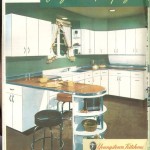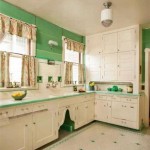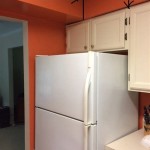Knotty Oak Kitchen Cabinets: A Blend of Rustic Charm and Enduring Quality
Knotty oak kitchen cabinets represent a specific aesthetic within kitchen design, marrying the natural beauty of oak wood with the distinctive character of its knots and grain patterns. This style offers a departure from more uniform and contemporary cabinet designs, emphasizing a rustic, warm, and often traditional ambiance. Understanding the features, benefits, and considerations associated with knotty oak cabinets is crucial for making informed decisions during kitchen renovations or new construction projects.
The term "knotty oak" refers to oak wood that retains its natural knots – the points where branches once grew from the tree. In standard clear oak cabinets, these knots are often removed or filled to create a smooth, uniform surface. However, with knotty oak, these imperfections are intentionally showcased, adding visual interest and a sense of history to the cabinetry. The wood is typically finished to highlight the grain and knots, emphasizing the natural variations and imperfections that contribute to its unique appeal. This type of wood is often less expensive than clear oak due to the reduced processing and waste involved in its production, making it an attractive option for budget-conscious homeowners seeking a distinctive look.
Aesthetic Appeal of Knotty Oak
The primary draw of knotty oak lies in its aesthetic appeal. It provides a visual texture and character that is absent in more refined wood finishes. The presence of knots, varying grain patterns, and natural color variations within the wood create a sense of warmth and authenticity. This aesthetic often aligns well with specific design styles, particularly those that emphasize natural materials and rustic charm. Some of these styles include:
*Farmhouse:
Knotty oak cabinets are a natural fit for farmhouse-style kitchens, complementing other rustic elements such as apron-front sinks, open shelving, and shiplap walls. The wood's inherent imperfections contribute to the overall feeling of a lived-in and welcoming space. *Country:
Similar to farmhouse, country-style kitchens benefit from the warmth and character of knotty oak. It pairs well with traditional hardware, such as antique brass or oil-rubbed bronze, and patterned textiles. *Rustic:
Knotty oak is a cornerstone of rustic design, which celebrates the raw beauty of natural materials. It is often combined with other rough-hewn elements, such as exposed beams, stone countertops, and reclaimed wood accents. *Transitional:
While primarily associated with traditional styles, knotty oak can also be incorporated into transitional kitchens as a way to add warmth and visual interest to a more contemporary design. It can be balanced with clean lines, neutral colors, and modern hardware.The specific finish applied to knotty oak significantly impacts its overall aesthetic. Lighter stains can highlight the natural color variations of the wood, creating a more airy and casual feel. Darker stains can add depth and richness, enhancing the wood's inherent character and lending a more formal or dramatic appearance. Painted finishes are also an option, although they can obscure some of the wood's natural grain and knot patterns. The choice of finish should be carefully considered to ensure it complements the overall design scheme of the kitchen.
Durability and Maintenance Considerations
Oak is a hardwood known for its strength and durability, making it a suitable material for kitchen cabinets that withstand daily use. Knotty oak, while retaining the inherent strength of oak, presents some unique considerations regarding durability and maintenance. The presence of knots can create variations in the wood's density, potentially making it more susceptible to expansion and contraction with changes in humidity. This can lead to cracking or warping over time if the wood is not properly sealed and finished. Proper installation is also crucial, ensuring that the cabinets are securely mounted and properly aligned to minimize stress on the wood.
Maintenance of knotty oak cabinets is generally straightforward, requiring regular cleaning with a mild soap and water solution. Abrasive cleaners should be avoided, as they can damage the finish and dull the wood. Periodic waxing or polishing can help to protect the finish and maintain the wood's luster. Any scratches or minor damage should be addressed promptly to prevent moisture from penetrating the wood, which can lead to more significant problems. Depending on environmental conditions, the cabinets may require re-sealing every few years to maintain optimal protection.
The finish on knotty oak directly impacts its resistance to stains, scratches, and moisture. A durable, high-quality finish is essential for protecting the wood and minimizing maintenance requirements. Consider options like polyurethane or conversion varnish, which offer superior protection compared to lacquer or shellac. It is also important to choose a finish that is compatible with the specific type of wood and intended use. Discuss the finish options with a cabinet maker or experienced contractor to ensure that the chosen finish provides adequate protection and durability for knotty oak cabinets.
Cost Factors and Sourcing
Knotty oak cabinets are generally more affordable than cabinets made from clear oak or other premium hardwoods. This is primarily due to the reduced processing and waste involved in their production. Because the knots are not removed, less material is discarded during the manufacturing process. However, the overall cost of knotty oak cabinets can vary depending on several factors, including:
*Cabinet construction:
Framed cabinets tend to be less expensive than frameless cabinets, as they require less precise joinery and material. The type of joinery used also affects the cost, with dovetail joints typically being more expensive than simpler butt joints. *Door style:
The design and complexity of the cabinet doors can significantly impact the cost. Simple, flat-panel doors are generally less expensive than raised-panel doors or doors with intricate detailing. *Finish:
The type of finish applied to the cabinets can also affect the cost. Custom finishes, such as distressed or glazed finishes, typically add to the overall price. *Hardware:
The type of knobs, pulls, and hinges chosen can impact the overall cost. High-end hardware can significantly increase the price of the cabinets. *Customization:
Custom-built cabinets are generally more expensive than stock or semi-custom cabinets. Customization allows for greater flexibility in terms of size, style, and features, but it also requires more labor and material.Sourcing knotty oak cabinets involves several options. Stock cabinets are readily available from big box stores; however, the quality and customization options may be limited. Semi-custom cabinets offer a balance between affordability and customization, allowing for some modifications to size and style. Custom-built cabinets, while the most expensive option, provide the greatest flexibility and allow for complete control over the design and construction. It is important to research different cabinet manufacturers and suppliers to compare prices, quality, and warranty options before making a decision. Local cabinet makers or experienced contractors can provide valuable advice and recommendations based on specific needs and budget considerations.
When selecting a supplier, it's prudent to examine the wood's origin and drying process. Kiln-dried oak is preferable, as it minimizes the risk of warping and cracking. Verify that the supplier uses sustainable forestry practices, ensuring the wood is sourced responsibly. Moreover, requesting samples of the wood is essential to assess the grain patterns, knot distribution, and finish options. This allows for a more informed decision and ensures that the selected cabinets align with the intended aesthetic.

Image Result For Knotty Oak Cabinet Rustic Kitchen Cabinets Hardware

23 Best Ideas Of Rustic Kitchen Cabinet You Ll Want To Copy Design Farmhouse Cabinets

Knotted Oak Kitchen Cabinets Rustic Other By Neighborhoods Home Improvement Houzz

67 The Top Rustic Farmhouse Kitchen Cabinets Ideas Cabinet Design Renovation

Rustic Kitchen Love Wood Kitchens

Schuller Rocca Maroon Knotty Oak German Kitchens

Custom Rustic Kitchen Cabinets Vienna Woodworks

Wood Kitchen Knotty Oak

Transitional Rustic Oak Ranch Style Kitchen Crystal Cabinets

European Oak Shaker
Related Posts








